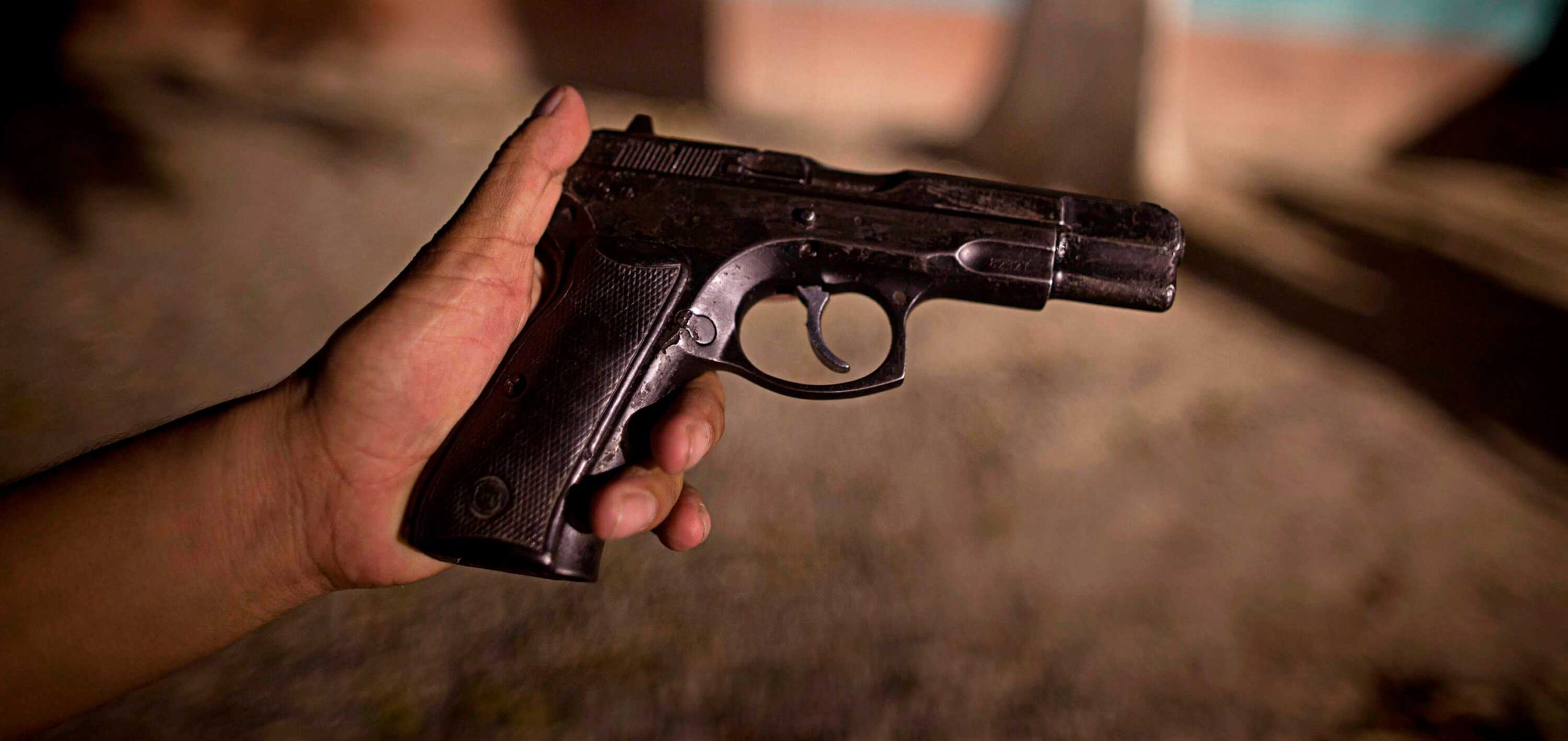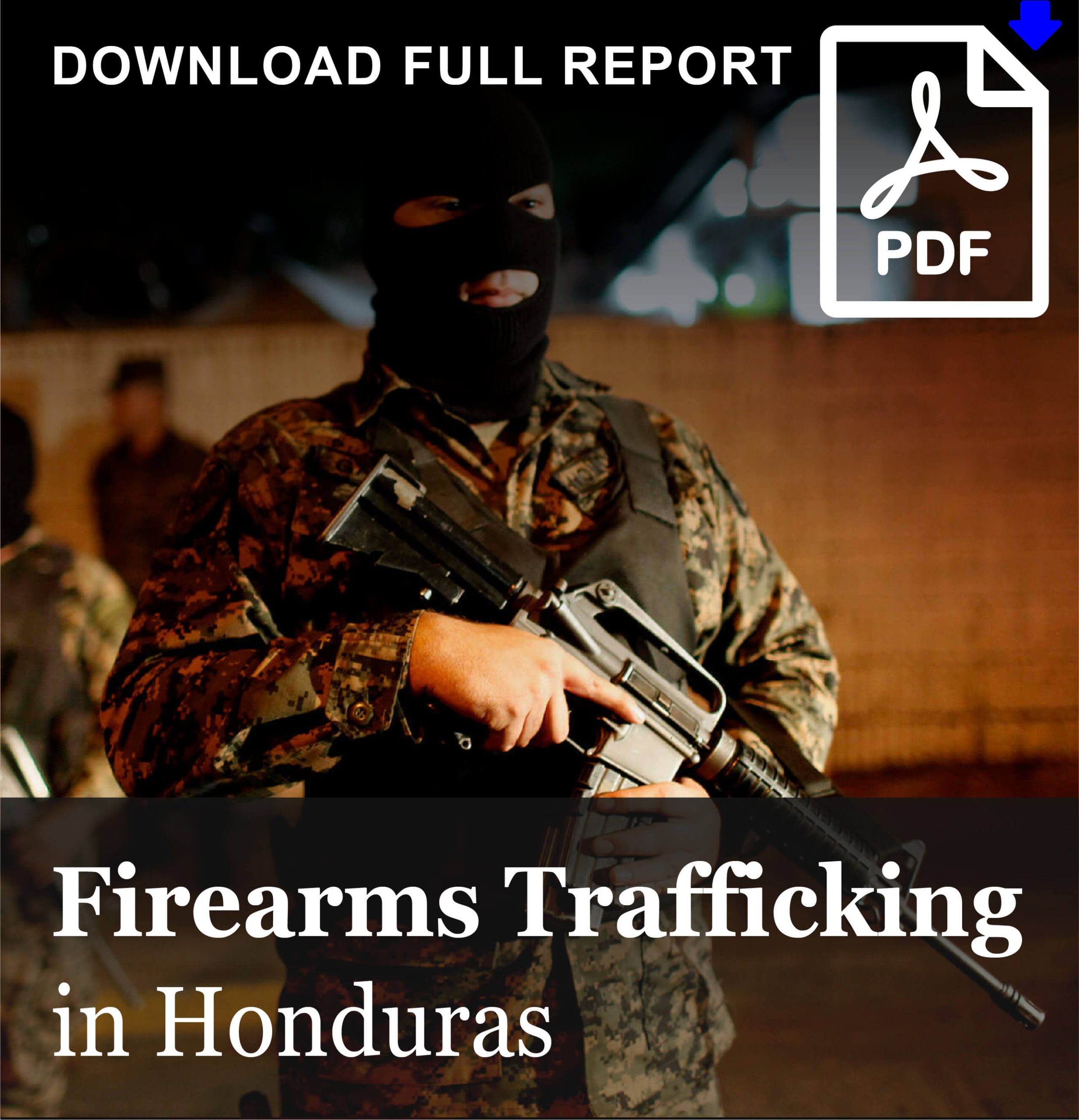Honduras does not produce weapons,[1] but weapons are trafficked into the country in numerous ways. These vary depending on weapon availability in neighboring countries, demand in Honduras, government controls and other factors. They do not appear to obey a single strategic logic, other than that of evading detection, although many of them have a single origin.
Nor does arms trafficking appear to be dominated by any one criminal group. In fact, arms trafficking appears to be as much a crime of opportunity for many individuals — uniformed and civilian alike — in Honduras as it is an established criminal activity for small and large groups of criminals, many of whom are also involved in other crimes such as international drug trafficking. The varied nature of the trade, the numerous means of trafficking weapons, and the shortfall in controls and regulatory agencies involved in policing it make this a very difficult crime to counter.
Source 1: The United States
The most important source for weapons trafficked into Honduras is the United States, according to Honduran and US officials interviewed for this report. The statements are supported by the available statistics. Honduran officials say that most of the non-registered weapons seized at crime scenes came from the United States. US officials say it is slightly less than half.
In a report issued in 2010, ATF said that as much as 40 percent of weapons recovered from Honduran crime scenes came from the United States.[2] The estimate was based on police statistics provided to the ATF and crossed with ATF’s own e-trace system, which tracks sales of weapons purchased in the United States; they traced 1,609 guns from Honduras between 2008 and June 15, 2011.
The results of the tracking also closely parallel that of the ballistics unit’s IBIS registry and the police seizures referenced earlier in this report. Of those traced, 84 percent were pistols or revolvers, and 6 percent were rifles. As it was with the IBIS and police seizure statistics, the brands most heavily represented were Smith & Wesson, Taurus and Beretta. More than 100 weapons were traced all the way back to gun shops in the United States, and nearly half of those traces led to Florida purchases.
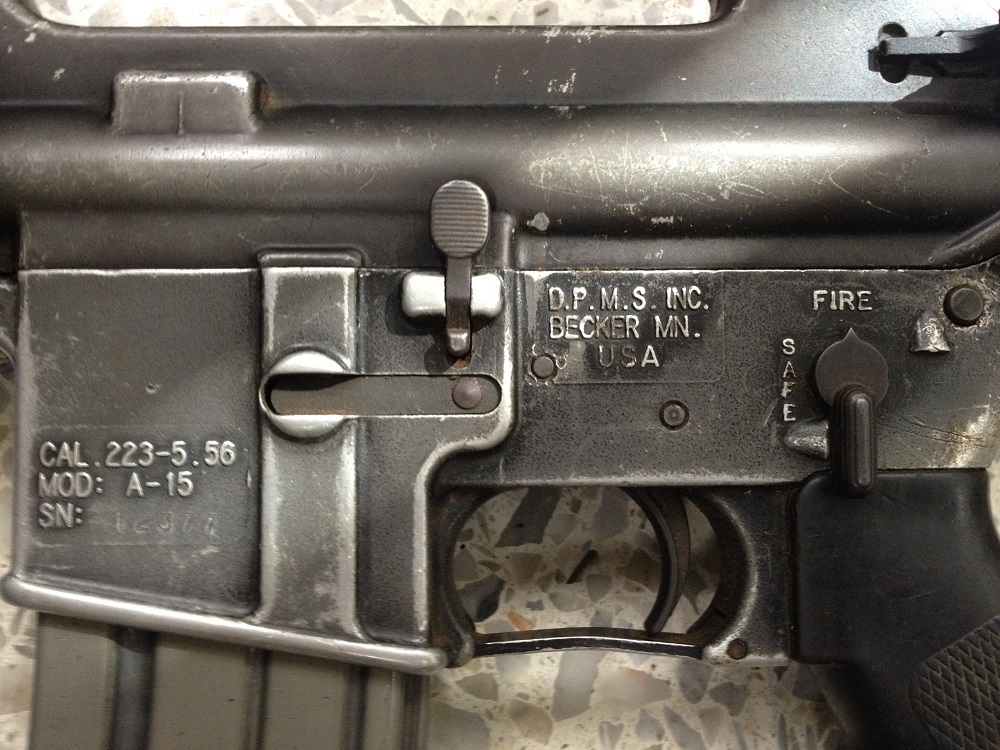
This percentage of weapons suspected to have been manufactured or imported into the United States has held steady over the years. According to a 2014 ATF report, 45.8 percent of the firearms recovered in Honduras and submitted to the ATF for tracing in 2013 — 386 of a total of 842 weapons traced — had been manufactured or imported from the United States.[3] Of the 842 traced, 85.6 percent were pistols or revolvers, and 8.7 percent were rifles. No data was given on makes or caliber of the weapons.
There are three major ways these weapons appear to be entering the country from the United States, according to interviews with Honduran and US officials, as well as individuals connected to the trade. First, they are trafficked into the country in small quantities via commercial airlines, hidden in passengers’ luggage.[4] This technique appears to be on the wane following the September 11, 2001 terrorist attacks in the United States, and due to increased controls at the airports and increased understanding of the law on the part of Honduran authorities.[5] Still, authorities in Honduras and other parts of Central America say this remains a fairly regular means of transporting weapons illegally, albeit in small quantities.
Second, traffickers hide weapons in legitimate imports of goods. One source described in detail to InSight Crime and ASJ how one of his relatives in the United States bought five Beretta Px4 Storm rifles in the United States and placed them in a used car that he sent to Honduras in a container among various other items — such as clothes and toys.[6] While InSight Crime and ASJ could not verify this story with the person who sent the items, it heard numerous similar stories of small-time trafficking operations that used this method.
Another source described how the source’s family moved weapons inside appliances, televisions and VHS machines, as well in the doors, trunks and upholstery of cars they would ship to Honduras. The source said the family would purchase the weapons from work colleagues or in a “flea market.”[7] Another method was to place weapons in aluminum foil and submerge them in paint, according to one source, who would then ship them via Miami. The source denied moving large numbers of weapons, but said his cousins were collecting and reselling dozens in the United States and Honduras.
The source said one cousin sent at least ten weapons in a shipment that he bought from a man who was selling weapons on the black market in North Carolina. The firearms were hidden in a car because, the source said, Honduran authorities never used to check the cars entering the country. The source’s relative in Honduras went to the port to claim the goods. Port authorities — who the relative says did not search the items — planned to hold the goods for several days, so the relative paid a bribe to have them released the same day. The relative claimed to have no knowledge that the weapons had been smuggled into the country prior to their arrival in Honduras. Later, the cousin told the relative that some men would be coming by to pick up the weapons.
Camouflaging weapons in imported goods also appears to be the preferred method of large criminal groups, according to the authorities and one source who worked as a private security guard for a criminal group in Honduras. The source said he had knowledge of how criminal groups moving weapons in bulk from the United States regularly paid personnel at the large ports to “turn off x-ray machines” or simply ignore the contents as they passed through.[8] Large weapons shipments necessitated these payments, he said. Police intelligence concurred with this assessment.[9] Neither the source nor the police offered an example illustrating this corruption, and both sources said this has become more difficult in the last several months with the implementation of a plan to use interagency units at the ports, among other measures.
There is at least one example of a US-based group facilitating the trafficking activities of a Honduran criminal organization or organizations. In 2010, the ATF and the Department of Justice prosecuted two US citizens and four Honduran nationals in Florida for trafficking weapons to Honduras and Puerto Rico.[10]
The investigation began in 2009 when ATF agents registered a large number of handgun purchases by Hugh Crumpler III.[11] A decorated Vietnam war veteran, Crumpler told authorities that he had trouble finding gainful employment until he started buying weapons at gun stores in Florida and selling them at gun shows in the state. ATF records showed Crumpler purchased 529 handguns in 62 transactions in 2009.[12] Among the weapons purchased were numerous Fabrique Nationale Herstal 5.7×28 mm semi-automatic handguns, also known as “matapolicias,” or cop killers, for their ability to pierce body armor at close range. (See picture below)
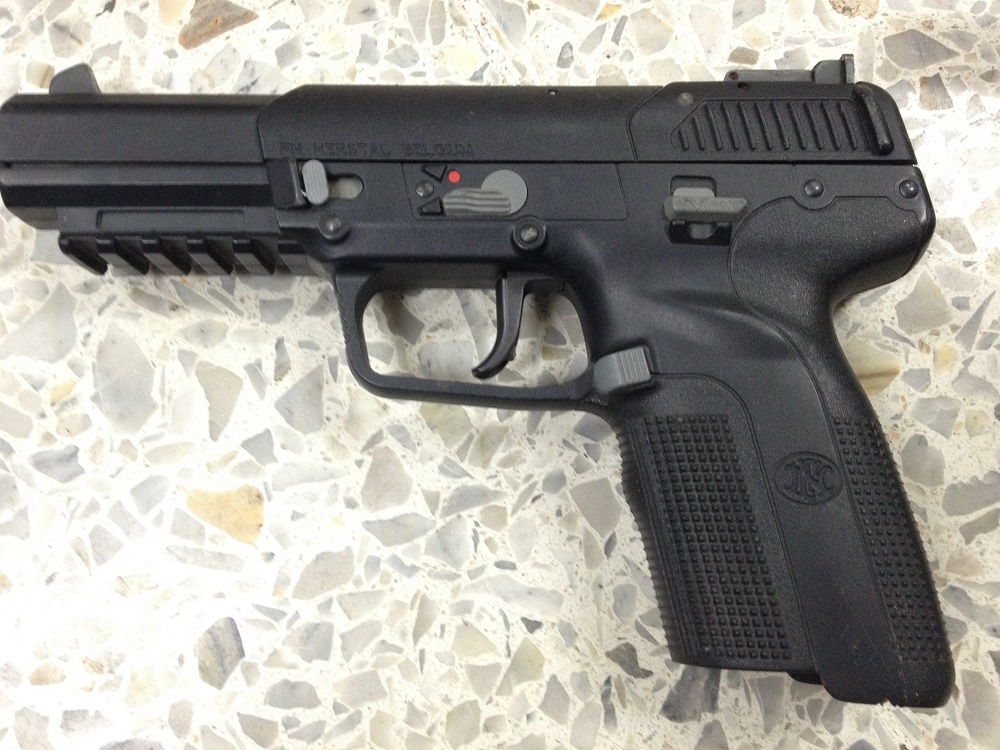
Crumpler also purchased and sent several assault rifles to be chrome-plated and get their barrels shortened.[13] In addition, Crumpler sold several rifles that had grenade launchers attached to them. By the end of the investigation, US agents monitoring Crumpler estimated that he had purchased 637 firearms worth an estimated $270,000. Crumpler purchased weapons from 19 different gun shops in Florida and four from out-of-state dealers. The ATF believed that Crumpler and an associate purchased an additional 200 to 300 firearms at various Florida gun shows.[14]
Crumpler’s top clients were a group of Hondurans, most of whom were residing undocumented in Orlando. US government investigators and prosecutors called them the “Alvina Way Orlando group” or the “7002 Alvina Way” for the address of a house where they met Crumpler and exchanged money for weapons on several occasions. The group received over $65,000, some of it via wire transfers from Honduras, to pay for the weapons. Many of these transfers came via individuals in Honduras who moved the money through Walmart’s MoneyGram system. In all, the ATF estimated that more than $163,000 was moved in this manner.
The group then hid the weapons in cars and appliances and shipped them to Honduras in containers, court documents say. The weapons included the FN pistols described above, Glock handguns and AR-15 assault rifles, all weapons of choice for criminal organizations operating in Honduras and elsewhere. One package that investigators followed netted 26 guns and rifles with an estimated street value of $25,000, court records show. The group packaged the items in a big box that weighed 215 pounds and included clothing, cookware and holiday decorations.
The Hondurans appeared to act in concert, meeting and negotiating with Crumpler as a group. But they also maintained separate accounts and did not pool their money to purchase the weapons. Indeed, there appeared to be at least four different cells acting independently in some respects. They spoke to Crumpler individually, arranged prices with him individually, and moved money in small increments via Walmart MoneyGram individually. It’s not clear if they did this to shield themselves from law enforcement or because they had their own, separate clientele in Honduras.
The case illustrated the importance of this network for the black market arms trade. Weapons that moved through Crumpler network were found in Puerto Rico crime scenes, in one case just 10 days after Crumpler bought the gun. As of June 2010, authorities in Colombia had recovered five Glocks from the Crumpler purchases, all of them in the hands of the feared crime syndicate the Oficina de Envigado. Another weapon was found in Panama. The ATF agent in charge of the investigation noted in his affidavit that, “a Cartel-led Drug Trafficking Organization (DTO) connection is suspected when the firearms and ammunition being ‘trafficked’ are popular with the Cartels, such as assault rifles (AR-15 type) and FN Five-seven pistols.”
“The firearm problem in Central and South America is similar to the drug problem in the United States in that it is extremely difficult to reduce the supply of the illicit items without first reducing the demand,” he added. “Any small reduction in supply leads to an increase in price, which further stimulates efforts to provide a supply. Therefore, as long as the demand for such weapons persists, people will continue to find creative ways to meet that demand and make a profit.”[15]
To be sure, sources in Honduras’ police, military and the Attorney General’s Office said that criminal groups were getting much of their weaponry from the United States, pointing to the recent seizure of dozens of weapons from the Valle Valle group.[16] The Valle Valle family was one of the most prominent drug trafficking organizations in Honduras prior to the arrest of its core members in August and September 2014. From one Valle Valle weapons cache, Honduran authorities traced two long guns and one pistol back to the United States.

The third way weapons have arrived from the United States is via legitimate military purchases, aid packages that include weaponry, or clandestine movement of weapons to proxy armies supported by the US government. Much of this weaponry came during the 1980s, the height of US-Honduran military relations. The US provided $2.5 billion of aid (in constant US dollars) between 1980 and 1989,[17] including $333 million in military assistance, second only to El Salvador in the region. The Soviet Union countered with its own military assistance to other parts of Central America.
Both US and Soviet weapons moved through official and non-official routes as part of the Cold War tit-for-tat. US and Soviet interlocutors also had connections to organized crime. One of the most notable examples in this regard was Colonel Leonidas Torres Arias, the head of the Honduran military’s “G2” intelligence service (the equivalent of the CIA) in the late 1970s, a staunch US ally. Torres Arias worked closely with Juan Ramon Matta Ballesteros, the legendary drug trafficker who was the intermediary between the Medellín Cartel in Colombia and the Guadalajara Cartel in Mexico. Torres Arias also had strong connections to Manuel Noriega, and fell out of favor with the United States when it became known that he was trafficking weapons to leftist guerrillas in El Salvador.[18]
In some respects, weapons from this tumultuous period remain a vibrant part of the black market in Central America. The lack of significant updates to the assault rifle, and its durability, means that many weapons from this period remain in circulation.[19] However, as the next section illustrates, much of this is due to the trade coming from Nicaragua, which received vast amounts of hardy AK-47 assault rifles. Leakage from military stocks also remains a concern. As the next section of this report illustrates, these include leakages from Nicaraguan, Salvadoran and Guatemalan barracks, some of which derive from US government exports.
Source 2: Neighboring Countries
The movement of criminal organizations as well as individuals within these Central American nations is fluid, suggesting that weapons procured in any one country can easily be used in another. In all, the United Nations estimates the Central American illegal arms market is worth about $14 million annually and moves about 70,000 weapons per year.[20]
“On its face, then, there is no real need to smuggle weapons into Central America,” the UN Office on Drugs and Crime (UNODC) writes. “The weapons are already there. But the location of the firearms and the location of the demand are not always the same, so considerable cross border trade exists. It is not really a matter of one country with a surplus feeding another with a shortage; rather, it is a matter of borders becoming irrelevant when someone wants to buy a gun.”[21]
The buyers include drug traffickers from all over the region who made Honduras their home. Among these were Guatemalan trafficker Mario Ponce, a one-time Zetas ally, who was captured and extradited from Honduras in 2011, and received a 25-year sentence in the United States;[22] Jose Natividad “Chepe” Luna, a Salvadoran national who established a region-wide transport service for drug trafficking organizations based in San Pedro Sula; and Cesar Gastelum Serrano, a top Sinaloa Cartel trafficker, who based himself mostly in San Pedro Sula for the last decade before being captured in Mexico.[23]
Nicaragua
According to various Honduran government sources, Nicaragua is a prime source of illegal weapons brought into the country. They offer scant evidence to back up this claim, but there is a plethora of unregistered weapons still circulating in the neighboring country. According to a United Nations report, there are 35 guns for every active-duty soldier in Nicaragua, compared to eight guns for every active-duty soldier in Honduras.[24] (In all, the UN report says there are 870,000 weapons registered to security forces in Central America, far surpassing the number of soldiers and police in the region.[25])
There are certain patterns in weapons movement from Nicaragua. They are often relics from the civil wars of years past, yet still functional and, of course, deadly. The AK-47 is the most notable among these older weapons. This is, in part, because the Sandinista government received these en masse in the 1980s to repel counterrevolutionaries from the US government’s proxy army, the Contras. Authorities also say they have recovered weapons with the serial numbers removed, or “liso,” something they say is more prevalent with weapons moving through Nicaragua.
A recent case in Nicaragua is a good illustration of how the country’s surplus is trafficked into Honduras. In 2013, a Nicaraguan judge convicted Gerardo Ocón Olivas of stealing 35 AK-47s and one AR-15 from police stocks and sentenced him to seven years in prison.[26] However, Ocón said in court that the weapons were being trafficked to Honduras by police commanders.[27] The modus operandi, he said, was to send the assault rifles to a workshop run by a police commander’s uncle for “maintenance,” when in reality they were sold to third parties. He added that this practice had been going on for at least four years. The police denied Ocón’s version; no officers were prosecuted.
At least part of this trafficking is related to recent history. Wars in Central America brought with them thousands of weapons. Between 1950 and 1990, the United States and the Soviet Union transferred tens of billions of dollars worth of weapons to the region, according to research by the Federation of American Scientists.[28] Between 1982 and 1987, the United States alone provided $1.1 billion worth of arms and equipment to El Salvador, Guatemala, Honduras, and Costa Rica.[29]
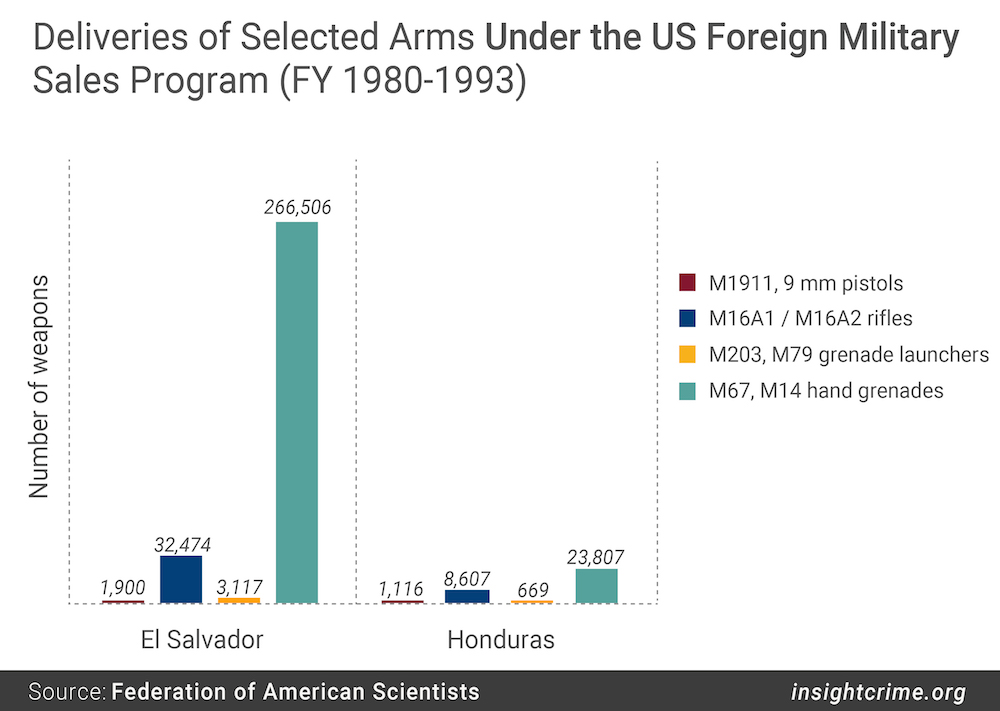
During the Cold War period, some weapons were legally imported to Central America, while others came via the black market, smuggled to revolutionary groups via Cuba or other third countries. Honduran military officials took part in these smuggling activities. As discussed above, the case of Torres Arias — a US ally marginalized when Washington found out about his arms deals with El Salvador’s Marxist rebels — is an example. Still other weapons came in legally and later entered the black market, a subject we will return to later in this report.
Guatemala
Other sites of the Central American civil wars are also potential suppliers for Honduras’ black market, most notably Guatemala. Guatemala has the largest arms market, by far, in the region. The country has an estimated 1.9 million weapons in circulation, according to Small Arms Survey data quoted by the UNODC, and fewer than 600,000 of them are legally registered to civilians or the security forces.[30] The World Bank put the number of firearms in civilian hands at 1.95 million, with only 147,000 legally registered.[31] Like Honduras, it has liberal gun laws and a vibrant private security economy that includes dozens of companies, many of which are run by ex-military personnel. Networking among these former members of the military with the government is near constant, resulting in a partially privatized state security apparatus.
The system leads to a lot of movement of weapons between government and private hands, and this trade is often criminal in nature. Weak and corrupt regulatory bodies have further opened the door for malfeasance and the creation of underground arms pipelines. Mexico’s criminal group the Zetas, for instance, used Guatemala as its virtual bodega for years. Between 2007 and 2009, the Mexican criminal group procured or stole thousands of handguns, rifles, rocket launchers and other military equipment, Guatemalan officials told InSight Crime and ASJ.
This leakage of official weapons is not limited to the Zetas. One recent Wilson Center report, citing ATF sources, said that an astounding nearly 85 percent of grenades and other military ordinance assessed by ATF officials — in a review of items seized by the Guatemalan police between 1997 and 2009 — could be traced back to military stockpiles.[32] The same report, citing a Washington Post story, said that by 2010, at least 27,000 weapons had leaked from Guatemalan stockpiles into Guatemalan and Mexican criminal hands.[33]
Honduran criminal groups capitalize on this market as well. Sources in the Attorney General’s Office told InSight Crime and ASJ that the Valle Valle group, mentioned earlier, procured weapons from its contacts in Guatemala, most notably, José Manuel López Morales, alias “El Ché,” a Chiquimula-based trafficker sought by US authorities.[34] It is not known yet which of the over 100 weapons and thousands of rounds of ammunition seized in 2014 by the Honduran authorities came from Guatemala. But heavy artillery such as an M60 machine gun and grenade launchers, both found amongst Guatemalan military stocks, were among the firearms seized in August 2014 by Honduran authorities when they raided Valle Valle properties.[35]
El Salvador
Leakage of weapons from El Salvador’s barracks is equally alarming. Several high profile cases have gone through the judicial system in recent years. These include one case of arms trafficking that reaches to the top of the Salvadoran military.[36] Other cases connected military personnel to leakage of grenades that were allegedly headed to the Zetas,[37] and the disappearance of four M60 machine guns (capable of firing 500 bullets per minute to a distance of 1,000 meters).[38]
Grenades were a particularly difficult item to get under control. The United States sent an estimated 300,000 grenades to Central America during the 1980s.[39] El Salvador was a prime recipient of US aid and grenades, receiving 266,506 M67 grenades between 1980 and 1993. (See graph above.) These grenades have been appearing in crime scenes from El Salvador to Mexico. The Salvadoran police told the Washington Post in 2010, for instance, that they had recovered 390 M67s in the previous five years.[40]
At least one high-profile case centered on Honduras after several military personnel implicated in a case involving the theft of grenades told prosecutors that at least 14, and as many 39, M72 light anti-tank weapons (LAW), had been stolen from Salvadoran stocks and sold to a Mexican drug cartel operating in San Pedro Sula.[41] Honduran authorities found the cache — which also included eight AK-47s, seven AR-15s, 11 rocket-propelled grenades, and mountains of ammunition, among other items — in March 2011.[42]
Mexico
Mexico is also a source of weaponry, although this appears to come largely from the regular flow of arms from the United States, because Mexico has tighter restrictions on the sale and ownership of guns than its neighbors. An estimated 253,000 weapons are purchased annually in the United States to be trafficked into Mexico, according to a report by the Igarapé Institute and the University of San Diego.[43] There appears to be a mix of entrepreneurial individuals, independent arms trafficking organizations, and criminal organizations exploiting liberal US gun laws.[44] Like drugs moving north, high-powered weapons moving south fetch a premium on the black market and can be traded for other illicit goods.
Mexican organizations can also pay for services rendered in Honduras with weapons, according to Honduran police intelligence services. In September 2014, Honduran authorities captured two Mexican nationals suspected of ties to the Valle Valle group, and seized an M60 machine gun, five fragmentation grenades and an M16 rifle.[45]
Panama
The UNODC notes that Panama is also an important hub in the region’s illegal arms trade, as the country allows duty-free arms purchases, so US weapons can be bought legally, and then smuggled into other countries. In the UNODC’s words, “This provides a convenient regional shopping center for the 9mm pistols that criminals demand.”[46]
* The InSight Crime team for this report was led by InSight Crime Co-director Steven Dudley and then InSight Crime Assistant Director Elyssa Pachico. Research was led by Steven Dudley and Mario Cerna, a long-time journalist from Honduras. The report was written by Steven Dudley. Special contributions were made by Mario Cerna. Translation into Spanish by Diego García and María Luisa Valencia. Editing and fact-checking by Mike LaSusa, Felipe Puerta and Victoria Dittmar. Graphics by Elisa Roldán. Top photo by Associated Press/Esteban Felix. Report photos by Steven Dudley. InSight Crime would like to give special thanks to ASJ for its support and assistance.
[1] There is a tradition of producing rudimentary, homemade weapons. The most recent examples are often found in the hands of street gangs. However, as the gangs have gained more revenue streams and the availability of weapons has increased, they increasingly obtain manufactured arms.
[2] Bureau of Alcohol, Tobacco, Firearms and Explosives, “Honduras,” a presentation by the Office of Strategic Intelligence Information, the Violent Crime Intelligence Division, and the Violent Crime Analysis Branch. Data between 1 January 2008 and 15 June 2011.
[3] Bureau of Alcohol, Tobacco, Firearms and Explosives, “Central America,” a presentation by the Office of Strategic Intelligence Information. Data as of 10 March 2014.
[4] There are an estimated 1 million Hondurans residing in the United States, according to the US State Department, and 600,000 are thought to be undocumented. The biggest flows of Hondurans arrived in the United States in the late 1990s and early 2000s, particularly after the devastation caused by Hurricane Mitch in 1998. As a result they largely missed the legalization program of the 1980s, meaning that a high proportion are undocumented. See: US State Department, Bureau Of Western Hemisphere Affairs, “U.S. Relations With Honduras,” 24 March 2014. Available at: https://www.state.gov/p/wha/ci/ho/index.htm. See also: Daniel Reichman, “Honduras: The Perils of Remittance Dependence and Clandestine Migration,” Migration Policy Institute, 11 April 2013. Available at: https://www.migrationpolicy.org/article/honduras-perils-remittance-dependence-and-clandestine-migration
[5] It is illegal to bring firearms into Honduras without a license from the Public Security Ministry. See “Ley de Control de Armas de Fuego, Municiones Explosiones y Otros Similares,” 2000. Available at: https://www.tsc.gob.hn/leyes/LEY%20DE%20CONTROL%20DE%20ARMAS%20DE%20FUEGO,%20MUNICIONES,%20EXPLOSIONES%20Y%20OTROS%20SIMILARES.pdf
[6] InSight Crime and ASJ interview, source who wished to remain anonymous, Tegucigalpa, 18-19 February 2015.
[7] “Flea market” is presumably a reference to gun shows, a common place of purchase and sale of weapons in the United States.
[8] InSight Crime and ASJ interview, source who wished to remain anonymous, Tegucigalpa, 18 February 2015.
[9] InSight Crime and ASJ interview, source from the police intelligence unit SERCAA, Tegucigalpa, 19 February 2015.
[10] Two suspects escaped and remain fugitives.
[11] Under US federal law, gun dealers are required to notify the authorities when an individual purchases more than two handguns in five business days. See Bureau of Alcohol, Tobacco, Firearms and Explosives, “ATF Fact Sheet – National Tracing Center,” 1 February 2013. Available at: https://www.atf.gov/resource-center/pr/atf-fact-sheet-national-tracing-center
[12] The bulk of this account comes the Sentencing Memorandum developed by the United States District Court, Middle District of Florida, Orlando Division, “United States of America v Hugh Crumpler, III, et al.,” 15 September 2010. Additional information was culled from the affidavit of ATF Agent Christopher W. Temple in the case against several of the Honduran defendants given on 5 February 2010.
[13] Short-barreled assault rifles require a license under US federal regulations, and are banned in some states. See: Bureau of Alcohol, Tobacco, Firearms and Explosives, United States Department of Justice, “National Firearms Act (NFA).” Available at: https://www.atf.gov/qa-category/national-firearms-act-nfa
[14] The ATF says Crumpler went to at least 12 gun shows between April 2008 and January 2010.
[15] Affidavit of ATF Agent Christopher W. Temple in the case against several of the Honduran defendants given on 5 February 2010, pp. 27 -28.
[16] Kevin Ortega, “Hallan arsenal supuestamente propiedad de los Valle en Honduras,” La Prensa, 21 August 2014. Available at: https://www.laprensa.hn/sucesos/policiales/740469-98/hallan-arsenal-supuestamente-propiedad-de-los-valle-en-honduras
[17] Peter Meyer, “Honduras-US Relations,” Congressional Research Service, 24 July 2013. Available at: https://fpc.state.gov/documents/organization/204124.pdf
[18] US Senate, “Drugs, Law Enforcement and Foreign Policy: A Report Prepared by the Subcommittee on Terrorism, Narcotics and International Operations of the Committee on Foreign Relations” (aka the Kerry Committee Report), December 1988, p. 74.
[19] Claudio Damian Rodriguez Santorum, et al., “Transnational Organized Crime in Central America and the Caribbean: A Threat Assessment,” United Nations Office on Drugs and Crime (UNODC), p. 59. Available at: https://www.unodc.org/toc/en/reports/TOCTACentralAmerica-Caribbean.html
[20] Ibid, p. 64.
[21] Ibid, p. 61.
[22] El Heraldo, “Narco guatemalteco extraditado por Honduras es condenado a 25 años de prision,” 23 August 2012. Available at:
[23] David Gagne, “Mexico Captures Sinaloa Cartel Head in Central America,” InSight Crime, 13 April 2015. Available at: /news/briefs/mexico-captures-sinaloa-cartel-head-in-central-america
[24] Claudio Damian Rodriguez Santorum, et al., “Transnational Organized Crime in Central America and the Caribbean: A Threat Assessment,” United Nations Office on Drugs and Crime (UNODC), p. 61. Available at: https://www.unodc.org/toc/en/reports/TOCTACentralAmerica-Caribbean.html
[25] Ibid, p. 61.
[26] Martha Vasquez, “Lo condenan por robo de armas,” La Prensa, 16 August 2013. Available at: https://www.laprensa.com.ni/2013/08/16/nacionales/158755-lo-condenan-por-robo-de-armas
[27] Martha Vasquez, “‘Comisionados trafican armas,’” La Prensa, 26 July 2013. Available at: https://www.laprensa.com.ni/2013/07/26/nacionales/156222-comisionados-trafican-armas
[28] Michael Klare and David Andersen, “A Scourge Of Guns: The Diffusion of Small Arms and Light Weapons in Latin America,” Arms Sales Monitoring Project, Federation of American Scientists, 1996, p. 27.
[29] Ibid, p.32.
[30] Claudio Damian Rodriguez Santorum, et al., “Transnational Organized Crime in Central America and the Caribbean: A Threat Assessment,” United Nations Office on Drugs and Crime (UNODC), p. 61. Available at: https://www.unodc.org/toc/en/reports/TOCTACentralAmerica-Caribbean.html
[31] World Bank, “Crime and Violence in Central America: A Development Challenge,” 2011, p. 20. Available at:
[32] Colby Goodman, “US Firearms Trafficking to Guatemala and Mexico,” Woodrow Wilson International Center for Scholars, April 2013, p. 8. Available at:
[33] Nick Miroff and William Booth, “Mexican Drug Cartels’ Newest Weapon: Cold War-Era Grenades Made in US,” The Washington Post, 17 July 2010. Available at: https://www.washingtonpost.com/wp-dyn/content/article/2010/07/16/AR2010071606252.html
[34] elPeriodico, “Se oyen pasos de animal grande: El Cartel de narcos Valle Valle empieza a caer,” 5 October 2014. Available at: https://www.elperiodico.com.gt/es/20141005/pais/2854/Se-oyen-pasos-de-animal-grande-El-Cartel-de-narcos-Valle-Valle-empieza-a-caer.htm
[35] InSight Crime and ASJ interview, Honduras prosecutor who wished to remain anonymous, Tegucigalpa, 25 May 2015.
[36] Seth Robbins, “El Salvador’s Military: Arms Dealer to the Maras?” InSight Crime, 16 June 2014. Available at: /news/analysis/el-salvadors-military-arms-dealer-to-the-maras
[37] Charles Parkinson, “El Salvador Arms Cache Exposes Texis Cartel – Zetas Link,” InSight Crime, 11 October 2013. Available at: /news/briefs/el-salvador-arms-cache-exposes-texis-cartel-link-to-zetas
[38] Marguerite Cawley, “El Salvador Arms Theft Highlights Military Weapons Trafficking,” InSight Crime, 9 July 2014. Available at: /news/briefs/el-salvador-arms-theft-highlights-military-weapons-trafficking
[39] Nick Miroff and William Booth, “Mexican Drug Cartels’ Newest Weapon: Cold War-Era Grenades Made in US,” The Washington Post, 17 July 2010. Available at: https://www.washingtonpost.com/wp-dyn/content/article/2010/07/16/AR2010071606252.html
[40] Ibid.
[41] Suchit Chavez, Jessica Avalos and Cesar Castro Fagoaga, “Cartel del Milenio compro cohetes Law que eran de la FAES,” La Prensa Gráfica, 23 April 2015. Available at:
[42] InSight Crime and ASJ interview, Attorney General’s Office representatives, Tegucigalpa, 25 May 2015.
[43] Topher McDougal, David A. Shirk, Robert Muggah and John H. Patterson, “The Way of the Gun: Estimating Firearms Traffic Across the US-Mexico Border,” Igarape Institute and the University of San Diego Transborder Institute, 5 March 2013.
[44] Steven Dudley, “How Guns are Trafficked Below the Border,” InSight Crime, 1 February 2011. Available at: /investigations/how-guns-are-trafficked-below-the-border
[45] La Prensa, “Decomisan una ametralladora de guerra M60 en Copan,” 16 September 2014. https://www.laprensa.hn/sucesos/policiales/748266-98/decomisan-una-ametralladora-de-guerra-m60-en-cop%C3%A1n
[46] Claudio Damian Rodriguez Santorum, et al., “Transnational Organized Crime in Central America and the Caribbean: A Threat Assessment,” United Nations Office on Drugs and Crime (UNODC), p. 62. Available at: https://www.unodc.org/toc/en/reports/TOCTACentralAmerica-Caribbean.html

